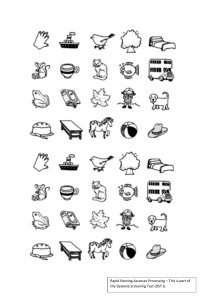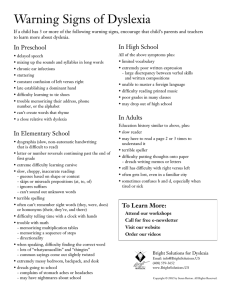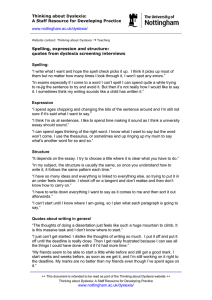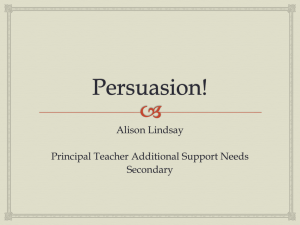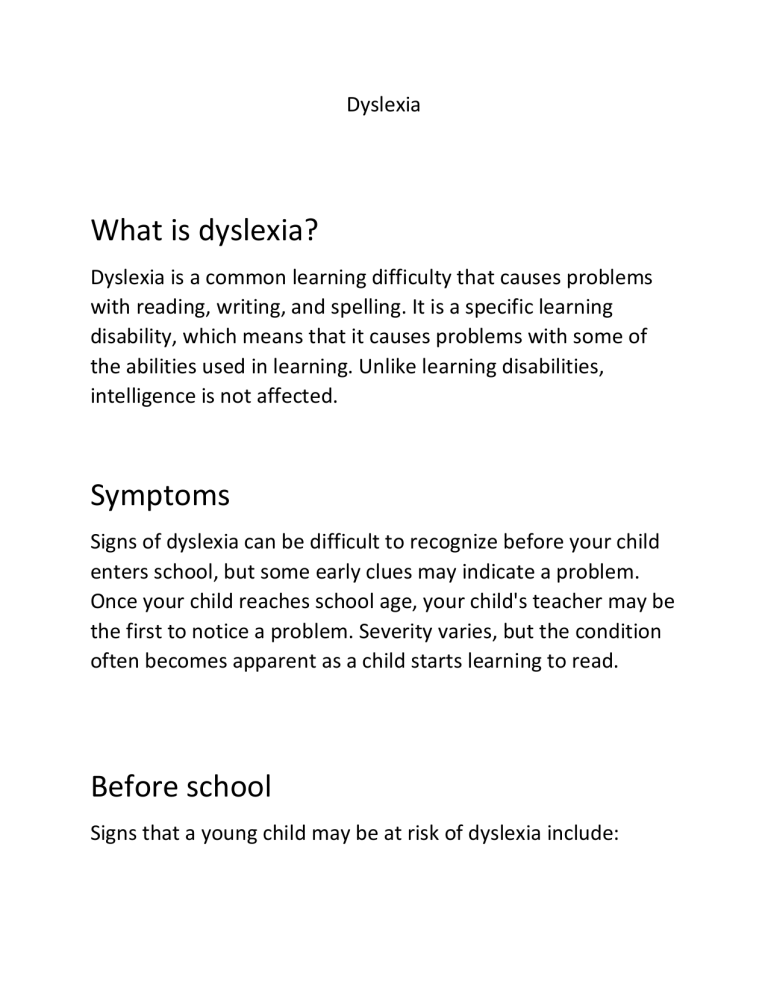
Dyslexia What is dyslexia? Dyslexia is a common learning difficulty that causes problems with reading, writing, and spelling. It is a specific learning disability, which means that it causes problems with some of the abilities used in learning. Unlike learning disabilities, intelligence is not affected. Symptoms Signs of dyslexia can be difficult to recognize before your child enters school, but some early clues may indicate a problem. Once your child reaches school age, your child's teacher may be the first to notice a problem. Severity varies, but the condition often becomes apparent as a child starts learning to read. Before school Signs that a young child may be at risk of dyslexia include: Late talking, Learning new words slowly, Problems forming words correctly, such as reversing sounds in words or confusing words that sound alike, Problems remembering or naming letters, numbers and colors and Difficulty learning nursery rhymes or playing rhyming games. School age Reading well below the expected level for age, Problems processing and understanding what is heard, Difficulty finding the right word or forming answers to questions, Problems remembering the sequence of things, Difficulty seeing (and occasionally hearing) similarities and differences in letters and words, Inability to sound out the pronunciation of an unfamiliar word, Difficulty spelling, Spending an unusually long time completing tasks that involve reading or writing and Avoiding activities that involve reading. Teens and adults Difficulty reading, including reading aloud, Slow and laborintensive reading and writing, Problems spelling, Avoiding activities that involve reading, Mispronouncing names or words, or problems retrieving words, Spending an unusually long time completing tasks that involve reading or writing, Difficulty summarizing a story, Trouble learning a foreign language and Difficulty doing math word problems. Causes Dyslexia results from individual differences in the parts of the brain that enable reading. It tends to run in families. Dyslexia appears to be linked to certain genes that affect how the brain processes reading and language. Overview Gladwell turns his attention to dyslexia, a brain disorder that makes it difficult for people to distinguish various sounds from one another. Dyslexia can also impact the way people learn to read, since it’s harder for people to grasp certain words on the page if they have “no concept of the sounds of language.” Taking this into consideration, Gladwell posits that nobody would wish dyslexia on their child, but he immediately challenges this notion by calling into question what, exactly, people tend to see as a disadvantage. He has already considered various advantages, he says, so now he wants to explore the things people think of as disadvantageous. In doing so, he references a concept known as “desirable difficulties,” suggesting that certain challenges sometimes have positive effects.To outline the concept of “desirable difficulty,” Gladwell presents readers with two questions, both of which comprise the world’s shortest intelligence test, which is known as the Cognitive Reflection Test (CRT). The questions are as follows: 1. A bat and a ball cost $1.10 in total. The bat costs $1.00 more than the ball. How much does the ball cost? Answer: the ball costs $0.05. 2. If it takes five machines five minutes to make five widgets, how long would it take 100 machines to make 100 widgets? Answer: it would take five minutes. Though seemingly straightforward, people often get these questions wrong because they measure the test taker’s ability to recognize when something “is more complex than it appears.” The Yale professor who invented this test gave it to students at nine different colleges, and their results were in keeping with their scores on other intelligence tests. On average, Harvard students only get 1.43 of the questions correct, proving that the test is quite hard. Strangely, though, people end up scoring better on the CRT if the test becomes a little harder. In a study at Princeton, the questions were written in a font that was difficult to read, and the average overall score increased to 2.45 from 1.9. There’s no doubt that the questions on the CRT are difficult— even high-achieving Ivy League students struggle with them, as evidenced by the fact that their average score is 1.43 out of 3. But when the questions become even harder, Princeton students improve their overall score. This is because the font change is a “desirable difficulty,” one that forces students to work just a little bit harder to read and, therefore, also forces them to slow down and really think. That this actually works aligns with Gladwell’s belief that disadvantages can sometimes become beneficial. ACTIVE THEMES Advantages and Disadvantages Theme Icon Hardship and Resilience Theme Icon Gladwell argues that the reason Princeton students did better on the CRT when it was harder to read is that it forced them to work just a little more than they would have otherwise. This, he says, is a “desirable difficulty,” or one that brings about positive results. Needless to say, not all challenges are desirable, as evidenced by Caroline Sacks’s experience at Brown. With this in mind, Gladwell asks if dyslexia might be a desirable difficulty and, to answer his own question, points out that one third of all successful entrepreneurs are dyslexic. Gladwell hypothesizes that this kind of success isn’t in spite of a person’s struggle against dyslexia, but because of it. ACTIVE THEMES Gladwell introduces David Boies, a man who grew up in rural Illinois and had a hard time in school from a very early age. Nobody knew it at the time, but he suffers from dyslexia, and to this day he has trouble reading because it takes him so long to get through even short passages. Fresh out of high school (which he barely finished), he took a job as a construction worker and eventually got married. When his wife became pregnant, though, she urged Boies to pursue more lucrative professions and the advanced degrees he’d need to do so. Deciding to go to law school, Boies attended to the University of Redlands, which Gladwell says was a small pond in which Boies could “excel.” While taking classes, Boies learned he could apply to law school without graduating college.

